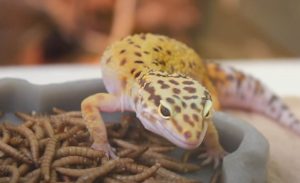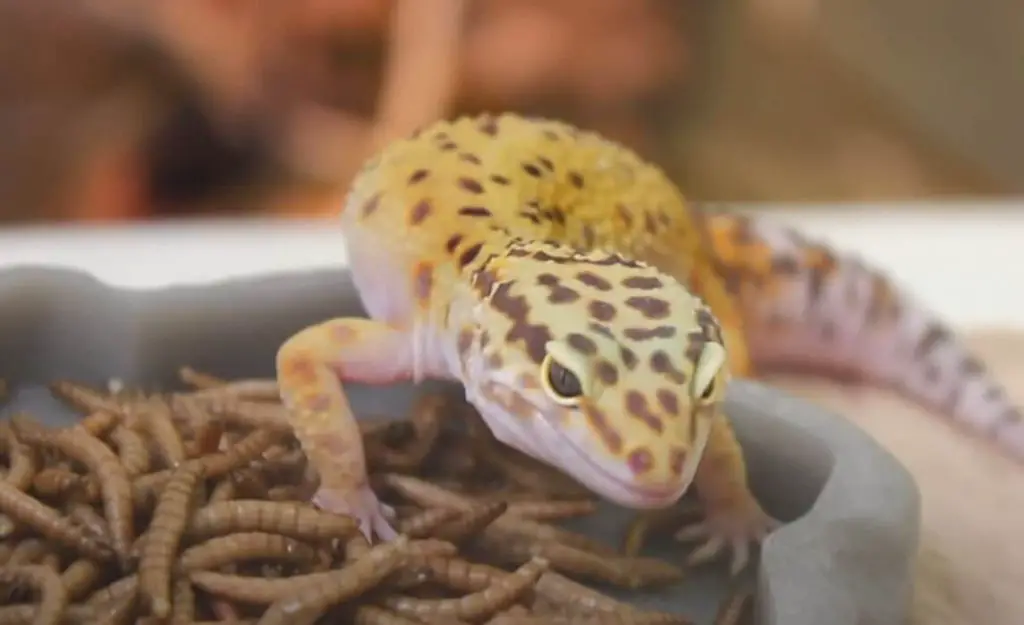Fat leopard gecko
Fat leopard gecko: Leopard geckos (Eublepharis macularius) have gained immense popularity as pet reptiles due to their unique and captivating characteristics. Originating from the dry regions of Afghanistan, Pakistan, and India, these nocturnal creatures have become a favorite among reptile enthusiasts across the globe. With their stunning appearance and relatively docile nature, leopard geckos have carved a special place in the hearts of many.
A Prized Pet
Leopard geckos are highly sought after for several reasons. Unlike many other reptiles, they are relatively small in size, with adults typically reaching around 8 to 10 inches in length. This manageable size makes them suitable for various housing arrangements, including terrariums and vivariums.
Additionally, their calm temperament makes them well-suited for beginners or those who prefer a reptile that can be handled with ease. However, what truly sets leopard geckos apart is their striking appearance.
These creatures come in a wide range of color variations and patterns, making each individual truly unique. The most common morphs include the traditional yellow or orange body with black spots, but there are also albino morphs that lack pigmentation altogether and possess mesmerizing red or pink eyes.
The Charm of Fat Leopard Geckos
 Among the fascinating traits exhibited by leopard geckos is the phenomenon of “fat” individuals within the population. These chubby fellows possess an endearing plumpness that distinguishes them from their slimmer counterparts. While it is important to note that obesity can lead to health issues in leopard geckos (which will be discussed later), fat individuals showcase a certain charm that captivates many keepers.
Among the fascinating traits exhibited by leopard geckos is the phenomenon of “fat” individuals within the population. These chubby fellows possess an endearing plumpness that distinguishes them from their slimmer counterparts. While it is important to note that obesity can lead to health issues in leopard geckos (which will be discussed later), fat individuals showcase a certain charm that captivates many keepers.
The extra weight carried by fat leopard geckos adds an adorable roundness to their appearance. Their tail becomes thicker and often sports more vibrant colors, further accentuating their allure.
These chubby geckos have become popular among reptile enthusiasts, with many keepers specifically seeking out fat individuals to add to their collections. Leopard geckos have garnered a significant following in the world of herpetology due to their manageable size, gentle demeanor, and stunning physical attributes.
The existence of fat leopard geckos adds an extra layer of fascination to these captivating creatures. As we delve deeper into understanding the traits and care requirements associated with fat leopard geckos, we will explore the implications of their weight on their health and well-being.
Understanding Leopard Geckos
A Reptilian Marvel: The Leopard Gecko
Leopard geckos, scientifically known as Eublepharis macularius, are one of the most captivating reptiles found in the pet trade. Native to arid regions of Afghanistan, Pakistan, and India, these enchanting creatures have become beloved pets worldwide due to their unique characteristics and relatively easy care requirements.
Their natural habitat consists of rocky deserts with sparse vegetation and warm temperatures. In captivity, their charm lies not only in their striking appearance but also in their fascinating behavior and gentle temperament.
The Beauty that Lies Within
 When it comes to physical appearance, leopard geckos possess an undeniable allure that sets them apart from other reptiles. These small-bodied creatures typically measure around 7 to 9 inches in length from nose to tail tip when fully grown. Their bodies are covered with a remarkable array of patterns and colors that vary among individuals.
When it comes to physical appearance, leopard geckos possess an undeniable allure that sets them apart from other reptiles. These small-bodied creatures typically measure around 7 to 9 inches in length from nose to tail tip when fully grown. Their bodies are covered with a remarkable array of patterns and colors that vary among individuals.
While the base coloration is usually a combination of yellow or cream shades, they can exhibit mesmerizing hues such as tangerine orange, deep reds or browns, pale pinks or lavenders, and even ghostly white variations. One of the defining features of a leopard gecko’s appearance is its spectacularly patterned skin.
Dark spots or blotches adorn their body along with fine stripes running along their backs. This pattern serves as camouflage in the wild but also adds an exquisite touch to their overall aesthetics.
Beyond Skin Deep: Behavior and Temperament
Leopard geckos are renowned for their docile nature and amiable demeanor towards humans when properly handled. Unlike some other reptile species that may be inclined towards aggression or skittishness, these geckos tend to be calm and curious by nature.
Being nocturnal creatures by preference makes them particularly fascinating. They exhibit a repertoire of behaviors during the night, including exploring their surroundings, hunting for prey, and engaging in social interactions.
Their nocturnal nature allows them to thrive in low-light conditions. Leopard geckos also possess an exceptional ability to communicate through various means.
Tail wagging is a distinct behavior displayed when they are content or seeking attention. Additionally, their tail plays a crucial role in storing fat reserves, which they can rely on during periods of scarce food availability.
Understanding leopard geckos entails appreciating the intricate details of their physical appearance, acknowledging their natural habitat and scientific classification (Eublepharis macularius), and comprehending their fascinating behavior and congenial temperament. These factors contribute to the allure that attracts individuals to keep these captivating reptilian companions as pets.
The Concept of “Fat” Leopard Geckos
A “fat” leopard gecko refers to an individual that is overweight or obese, exceeding the healthy weight range for their species. While leopard geckos naturally have a plump appearance due to their naturally thick tail and body, there is a clear distinction between a healthy weight and being overweight.
Fat leopard geckos often display excessive fat deposits around their abdomen and tail, which can be visually noticeable and palpable. When assessing whether a leopard gecko is considered “fat,” it is essential to compare its body condition to established guidelines.
A healthy leopard gecko should have an evenly distributed fat layer beneath its skin, allowing for easy movement without any restrictions or excessive bulges. In contrast, excessive adipose tissue accumulation in specific areas indicates obesity in these reptiles.
Factors that Contribute to a Leopard Gecko Becoming Overweight
Diet plays a significant role in the development of obesity in leopard geckos. These reptiles are opportunistic feeders and possess voracious appetites, making them prone to overeating if not properly monitored.
Feeding them inappropriate portion sizes or providing high-fat live prey such as mealworms can contribute to weight gain over time. Inadequate exercise also plays a crucial part in the development of obesity among leopard geckos.
Unlike their wild counterparts, pet geckos do not need to actively hunt for food or engage in natural behaviors like climbing or exploring large territories. The limited space provided in captivity can lead to sedentary lifestyles with minimal physical activity, ultimately leading to weight gain.
Health Implications and Risks Associated with Obesity in Leopard Geckos
Obesity poses several health risks for fat leopard geckos. Excess body weight places strain on their organs, potentially leading to cardiovascular problems and difficulties regulating body temperature. Obese geckos may also experience reduced mobility, making it challenging for them to move and properly shed their skin, which can lead to skin infections or other dermatological issues.
Furthermore, obesity in leopard geckos can impact their reproductive health. Female geckos may struggle with egg laying complications due to excess weight putting pressure on their reproductive organs.
Males may experience reduced fertility as obesity can influence hormone levels and sperm quality. Additionally, overweight individuals are more prone to developing metabolic disorders such as fatty liver disease.
Understanding the concept of fat leopard geckos entails recognizing what constitutes overweight in these reptiles and identifying the factors that contribute to obesity. It is important for owners to be aware of the health implications associated with excess weight in order to take necessary steps towards prevention, ensuring the overall well-being of these fascinating creatures.
Diet and Nutrition for Fat Leopard Geckos
An Overview of the Ideal Diet for Leopard Geckos
Leopard geckos are insectivores, meaning their primary diet consists of a variety of insects. These creatures thrive on a diet rich in protein and calcium to maintain their overall health and vitality.
When it comes to feeding your fat leopard gecko, it is essential to understand the ideal diet for these reptiles. The foundation of a leopard gecko’s diet should consist of appropriately sized live insects such as crickets, mealworms, waxworms, or dubia roaches.
These insects should be gut-loaded before feeding them to your gecko. Gut-loading involves providing the feeder insects with high-quality nutrition to pass on those nutrients to the gecko upon consumption.
This process ensures that your leopard gecko receives all the necessary vitamins and minerals it needs. Furthermore, while insects form the core part of their diet, supplementation is crucial to ensure they are getting all vital nutrients.
Calcium supplements with vitamin D3 should be dusted onto their food at least once or twice a week. This supplementation helps prevent metabolic bone disease commonly associated with inadequate calcium levels in reptiles.
Specific Dietary Recommendations for Overweight or Obese Individuals
If you find that your beloved leopard gecko has become overweight or obese, dietary adjustments must be made to help them shed excess weight and maintain optimal health. The first step is portion control and feeding frequency adjustments.
Instead of leaving an unlimited amount of food in their enclosure at all times, offer controlled portions suitable for their size and age. Feeding frequency should also be adjusted accordingly.
It is recommended to feed adult leopard geckos every two days, while younger individuals may require more frequent meals every day or every other day until they reach maturity. In addition to portion control and adjusted feeding schedules, introducing healthier food options can significantly benefit overweight or obese leopard geckos.
Offer gut-loaded insects that have been fed with nutritious foods such as leafy greens, carrots, or sweet potatoes. Supplement their diet with small amounts of fresh fruits and vegetables like papaya or butternut squash to provide natural vitamins while keeping their overall caloric intake in check.
By following these specific dietary recommendations, you can help your fat leopard gecko achieve and maintain a healthy weight while ensuring they receive a well-balanced diet that meets their nutritional needs. (Note: It is important to consult a veterinarian experienced in reptile care before making any significant changes to your leopard gecko’s diet.)
Exercise and Enrichment for Fat Leopard Geckos
Importance of Physical Activity for Overall Health and Weight Management in Reptiles
Physical activity plays a crucial role in maintaining the overall health and weight management of leopard geckos, especially those that are overweight or obese. Regular exercise helps stimulate their metabolism, promote muscle tone, and prevent lethargy. Engaging in physical activities also aids in preventing common health issues associated with obesity, such as fatty liver disease and skeletal problems.

Suggestions for Creating an Enriched Environment to Encourage Movement
To encourage movement and exercise in fat leopard geckos, it is essential to create an enriched environment within their enclosure. Providing hiding spots, such as rock formations or artificial caves, not only mimics their natural habitat but also encourages exploration and physical activity. Additionally, incorporating climbing structures like branches or vines enables them to engage their muscles while exploring different levels within their enclosure.
Moreover, introducing obstacles like small tunnels or ramps can stimulate movement by making them navigate around the enclosure. Regularly rearranging the setup can also help to keep them mentally stimulated while encouraging exploration and activity.
Medical Considerations for Fat Leopard Geckos
Potential Health Issues Related to Obesity in Leopard Geckos
Obesity in leopard geckos can lead to various health issues that can severely impact their well-being. One of the most common problems is fatty liver disease (hepatic lipidosis), which occurs when excessive fat accumulates within the liver tissues. This condition can disrupt normal liver function and lead to organ failure if left untreated.
Furthermore, obesity increases the risk of metabolic bone disease (MBD) due to inadequate calcium absorption caused by reduced vitamin D synthesis under excess body fat. MBD weakens the bones, making them more susceptible to fractures, deformities, and overall skeletal issues.
Discussion on When to Seek Veterinary Care
If you notice your leopard gecko is overweight or obese, it is crucial to seek veterinary care promptly. A reptile veterinarian will conduct a thorough examination and assess the overall health of your gecko. They may recommend diagnostic tests such as blood work or radiography to evaluate the extent of the weight-related health issues.
Veterinary intervention is especially important if your leopard gecko shows signs of lethargy, decreased appetite, difficulty moving, or any other abnormal behavior. Early detection and treatment can significantly improve their chances of recovery and prevent further complications.
Treatment Options Available to Help Obese or Overweight Individuals
 Treating obesity in leopard geckos involves a comprehensive approach that includes dietary adjustments, exercise encouragement, and potential medical interventions prescribed by a qualified reptile veterinarian. The primary focus should be on gradually reducing their caloric intake while ensuring they receive proper nutrition through a balanced diet.
Treating obesity in leopard geckos involves a comprehensive approach that includes dietary adjustments, exercise encouragement, and potential medical interventions prescribed by a qualified reptile veterinarian. The primary focus should be on gradually reducing their caloric intake while ensuring they receive proper nutrition through a balanced diet.
In some cases, veterinarians may prescribe medication or supplements tailored for weight management in reptiles. These treatments aim to promote metabolism regulation and support overall health during the weight loss journey.
Preventing Obesity in Leopard Geckos
Tips on Maintenance
Preventing obesity in leopard geckos is always better than treating it afterward. Here are some essential tips for maintaining a healthy weight:
Balanced diet: Provide appropriately sized prey items at regular intervals while considering their age and size.
Portion control: Avoid overfeeding as it can lead to excessive weight gain.
Exercise opportunities: Create an enriched enclosure with hiding spots, climbing structures, and obstacles that encourage movement.
Monitor body condition: Regularly assess your gecko’s body condition by observing their shape, feeling for excess fat deposits, and consulting with a reptile veterinarian if needed.
Regular veterinary check-ups: Schedule routine examinations with a reptile veterinarian to ensure your leopard gecko’s overall health and catch any weight-related issues early on.
Providing ample exercise opportunities, creating an enriched environment, and being proactive about medical considerations are crucial in combating obesity in leopard geckos.
By implementing the prevention tips and seeking veterinary care when necessary, you can ensure the overall well-being of your pet and help them lead a happy, healthy life. Remember that with proper care and attention, it is possible to maintain a healthy weight for your beloved fat leopard gecko!


